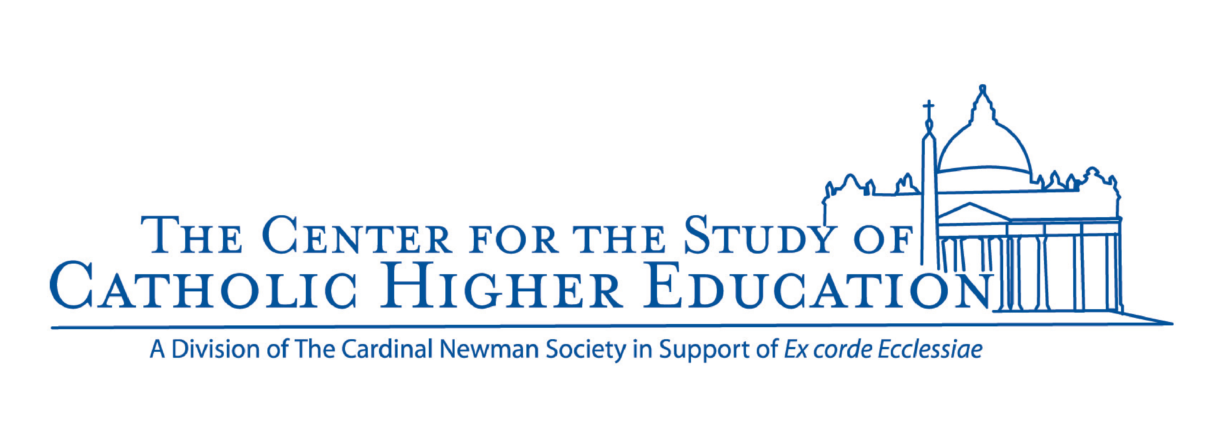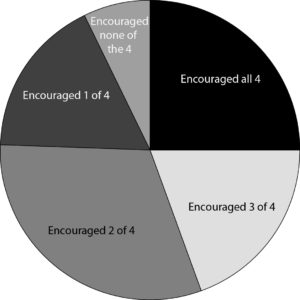Behaviors and Beliefs of Current and Recent Students at U.S. Catholic Colleges
This analysis is based on a national survey of current and former undergraduate students at Roman Catholic colleges and universities in the United States, conducted by QEV Analytics for The Cardinal Newman Society. In total, 506 respondents participated: 251 current students and 255 recent graduates or attendees under 30 years of age. Data were collected in May and June of this year. The theoretical margin of sampling error is plus or minus 4.4% at the 95% confidence level.
This survey was administered on-line, utilizing a sample developed by a commercial sample vendor (Peanut Labs). The vendor develops its sample through social networking Internet sites and reports a recruitment pool of 10 million. The obtained sample of 506 current and recent students was weighted by age (18-29) to achieve an even distribution, and by institution to limit attendees of any one institution to 3% of the sample.
General Characteristics of Respondents
Half of the respondents are currently students at Catholic colleges and universities. Nearly one-quarter (23%) have graduated from a Catholic college or university, almost all of them since the year 2000. Just more than a quarter (27%) are former students at a Catholic college or university, but did not graduate from that institution.
The majority of respondents are female (57%). This corresponds closely to trends in U.S. undergraduate enrollment reported by the U.S. Census Bureau: a majority of college undergraduates have been women since 1979, holding steadily around 56% from 2000 to 2006.
Fifty-eight percent (58%) of respondents identify themselves as Catholic today and also while they were students at Catholic colleges and universities. Six percent (6%) were Catholic in college, but not now (only one percent were not Catholic in college but are now). Another 29% were not Catholic in their last year of college and are not currently Catholic.
For comparison in this report, we use the term “sacramentally-active Catholic”—those who attend Mass at least once a week and participate in the Sacrament of Reconciliation at least once a year. Just more than half (53%) the respondents report participating in a Catholic Mass at least weekly during their last year at a Catholic college or university. Sixty-one percent (61%) report participating in the Sacrament of Reconciliation at least once in their most recent year attending a Catholic institution. We combined these results to identify respondents who were sacramentally-active Catholics during their last year at a Catholic college or university. While 65% of our sample considered themselves to be Catholic while attending a Catholic college, only 48% of respondents actually participated in the Sacraments with the frequency required of faithful Catholics.
More than half (54%) the respondents report a G.P.A. of 3.5 or higher while attending a Catholic college or university. Nearly a quarter (23%) achieved grades of 3.8 or higher.
Representation of Students at Catholic Colleges and Universities
This random sample of students who attend or recently attended U.S. Catholic colleges and universities provides statistically valid results applicable to current and recent undergraduate students at Catholic institutions generally in the United States, within the theoretical margin of sampling error.
Respondents have attended at least 128 different Catholic colleges and universities, representing 62% of the universe of 208 institutions with undergraduate programs for lay students. These may not include colleges and universities attended by 101 respondents (20% of the total sample) who provided ambiguous school names (e.g. “St. Mary’s,” which could apply to several institutions).
We undertook a review of the respondents to evaluate characteristics of the colleges and universities they attended, in comparison to all students currently attending Catholic colleges and universities. We relied primarily on publicly available enrollment, location and admissions selectivity data from the National Catholic College Admission Association (NCCAA). For several Catholic colleges and universities not included in the NCCAA data set, and missing data for institutions affiliated with NCCAA, we relied on publicly available data from Peterson’s college guides.
The survey respondents, all under 30 years of age, attended Catholic colleges and universities over a span of several years, but our comparison data is for current students only. Some change in the enrollment and admissions selectivity characteristics of each college and university is likely over time. Respondents who provided ambiguous school names were not included in the analysis.
Acknowledging the limitations inherent in any survey research of this kind, we found a high degree of comparability between the obtained survey sample and the profile of current students at Catholic colleges and universities.
| All Current Students at Catholic Colleges & Universities |
Survey Respondents (unweighted) |
|
| Locale of School | ||
| Rural/Small Town | 8% | 11% |
| Suburban | 48% | 46% |
| Urban | 44% | 43% |
| Selectivity of School | ||
| Open | 5% | 4% |
| Moderately Selective | 39% | 45% |
| Selective | 46% | 35% |
| Very Selective | 10% | 16% |
| Region of School | ||
| North East/Mid Atlantic | 31% | 35% |
| South | 6% | 11% |
| Midwest | 48% | 35% |
| West | 15% | 20% |
| Student Body | ||
| <2,000 | 26% | 28% |
| 2,000 – 2,999 | 22% | 28% |
| 3,000 – 4,999 | 25% | 19% |
| >5,000 | 26% | 25% |
Goings-On, On Catholic Campuses
Certain behaviors of many students at America’s Catholic colleges and universities conform more closely to prevailing cultural norms than to traditional Catholic morality:
- During their last year at a Catholic college or university, 46% of current and recent students engaged in sex outside of marriage (including 41% of respondents who say they were sacramentally-active Catholics during that year).
- While attending a Catholic college or university, 84% of respondents had friends who engaged in premarital sex.
- During their last year at a Catholic college or university, 27% of respondents regularly viewed pornography (including 28% of then sacramentally-active Catholics).
- While attending a Catholic college or university, 19% of respondents personally knew a student who had an abortion or paid for someone else to have one.
- During their last year at a Catholic college or university, 31% of respondents regularly got drunk (including 27% of then sacramentally-active Catholics).
- While attending a Catholic college or university, 59% of respondents had friends who regularly used drugs for recreational purposes.
| All | Catholic While in College | Sacramentally Active in College | ||||
| YES | NO | YES | NO | YES | NO | |
| During last year at Catholic college or university engaged in sex outside of marriage | 46% | 48% | 45% | 53% | 41% | 56% |
| During last year at Catholic college or university, regularly viewed pornography | 27% | 68% | 26% | 69% | 28% | 68% |
| During last year at Catholic college or university, regularly got drunk | 31% | 65% | 30% | 68% | 27% | 69% |
| While attending Catholic college or university, knew student who had or paid for abortion | 19% | 76% | 18% | 78% | 19% | 79% |
| All | Catholic While in College | Sacramentally Active in College | |||||||
| None | Less Than Half | Half or More | None | Less Than Half | Half or More | None | Less Than Half | Half or More | |
| Close friends who drank alcohol regularly | 7% | 27% | 64% | 10% | 31% | 58% | 13% | 40% | 46% |
| Close friends who regularly used drugs for recreational purposes | 36% | 36% | 23% | 40% | 36% | 21% | 44% | 34% | 19% |
| Close friends who engaged in sex outside of marriage | 10% | 26% | 58% | 14% | 30% | 54% | 17% | 38% | 42% |
Each negative behavior tends to correlate with other negative behaviors. For instance, among those who had premarital sex during their last year at a Catholic college or university, 51% also regularly got drunk and 39% regularly viewed pornography that same year—as compared to 15% and 18% of students who abstained from sex during their last year. Among those who regularly got drunk during their last year at a Catholic college or university, 74% also had sex and 47% regularly viewed pornography that same year—as compared to 34% and 18% of those who did not get drunk regularly during their last year.
The negative behaviors of respondents strongly coincide with having friends who engage in the same or other negative behaviors. About two-thirds (64%) of respondents say that half or more of their close friends at a Catholic college or university drank alcohol regularly; 40% of those respondents got drunk regularly in their last year at the Catholic institution, as compared to 17% of students with a majority of friends who did not drink regularly. Among respondents who reported that half or more of their close friends at a Catholic college or university engaged in premarital sex (58% of the sample), nearly two-thirds (64%) had premarital sex in their last year, as compared to 23% of students with a majority of friends who abstained from sex.
Respondents who were Catholic in college—and especially sacramentally-active Catholics—are somewhat less likely to have engaged in negative behaviors. The difference, however, is not always very large given the Catholic Church’s strong teaching against these behaviors. We find no more than a five-point difference between all respondents and sacramentally-active Catholics with regard to having premarital sex and getting drunk during their last year at a Catholic college or university. There is no significant difference on viewing pornography. There are significant differences, however, in the behavior of close friends of sacramentally-active Catholics. Catholic students are just as likely to know a student who had an abortion or paid for someone to have an abortion.
Dissent from Catholic Teaching
Most respondents, including Catholics, disagree with traditional Catholic teachings on key moral issues and the priesthood, but Catholic respondents are more in accord with Catholic teachings on matters of dogmatic theology.
- Sixty percent (60%) agree strongly or somewhat that abortion should be legal (including 53% of those who currently identify as Catholic, and half those who were sacramentally-active Catholics during their last year at a Catholic college or university).
- Sixty percent (60%) agree strongly or somewhat that premarital sex with someone you really care about is not a sin (including 55% of current Catholics, 53% of sacramentally-active Catholics).
- Seventy-eight percent (78%) disagree strongly or somewhat that using a condom to prevent pregnancy is a serious sin (including 73% of current Catholics, 69% of sacramentally-active Catholics).
- Fifty-seven percent (57%) agree strongly or somewhat that same-sex marriage should be legal (including 53% of current Catholics, 48% of sacramentally-active Catholics).
- Sixty-one percent (61%) of both current Catholics and sacramentally-active Catholics agree strongly or somewhat that women should be allowed to be ordained as Catholic priests.
- Nearly two-thirds (64%) of both current Catholics and sacramentally-active Catholics agree strongly or somewhat that the fullness of God’s truth is found in the Catholic Church.
- Just more than two-thirds of current Catholics (67%) and sacramentally-active Catholics (69%) agree strongly or somewhat that the communion bread and wine at a Catholic Mass truly become the Body and Blood of Jesus Christ.
| All | Currently Catholic | Sacramentally Active in College | ||||
| Agree | Disagree | Agree | Disagree | Agree | Disagree | |
| “At a Catholic Mass, the communion host and wine truly become the Body and Blood of Jesus Christ.” | 49% | 36% | 67% | 24% | 69% | 23% |
| “The fullness of God’s truth is found in the Catholic Church.” | 43% | 41% | 64% | 26% | 64% | 28% |
| “Women should be allowed to be ordained as Catholic priests.” | 63% | 22% | 61% | 29% | 61% | 30% |
| “The law should permit marriage between two people of the same sex.” | 57% | 35% | 53% | 40% | 48% | 46% |
| “Sex before marriage with someone you really care about is not a sin.” | 60% | 36% | 55% | 42% | 53% | 44% |
| “Women should have the legal right to have an abortion.” | 60% | 31% | 53% | 39% | 50% | 43% |
| “Using condoms to prevent pregnancy is a serious sin.” | 15% | 78% | 19% | 73% | 24% | 69% |
With regard to traditional Catholic teaching, the average number of canonically correct answers for all respondents is two (out of seven); for respondents who were sacramentally-active Catholics during their last year at a Catholic college or university, it is three.
These next several questions gauge the morality of various acts. In the following table, we have combined the responses “always morally acceptable” with “usually morally acceptable;” “usually morally wrong” with “always morally wrong.” Here respondents are less in conflict with Catholic teaching, and a stronger difference is seen for current Catholics and respondents who were sacramentally-active Catholics during their last year at a Catholic college or university.
| All | Currently Catholic | Sacramentally Active in College | ||||
| Moral | NOT Moral | Moral | NOT Moral | Moral | NOT Moral | |
| “Sex between college students who are not married.” | 50% | 44% | 43% | 52% | 41% | 56% |
| “Sex with someone of the same sex.” | 40% | 49% | 33% | 57% | 30% | 62% |
| “The regular viewing of pornography.” | 41% | 52% | 34% | 60% | 34% | 61% |
| “Having an abortion.” | 29% | 63% | 25% | 69% | 24% | 72% |
Nearly half (47%) of the respondents who say that an abortion is usually or always morally wrong agree with the proposition that abortion should be legal. This is evidence that some respondents are reluctant to use the law to enforce a moral judgment, a reluctance also found among Catholic adults generally. This phenomenon is also visible to a lesser extent on the question of same-sex marriage. One third of those who hold that sex between persons of the same sex is usually or always morally wrong also agree same-sex marriage should be legal.
Student Activities
We asked respondents about their participation in extracurricular activities that are associated with three common emphases of Catholic educators: community service and promoting social justice, advocating respect for human life at all its stages, and spiritual development in the Catholic faith.
Half (50%) the respondents reported that while a student at a Catholic college or university, they participated “in an organization or program devoted to community service, alleviating human suffering, or otherwise concerned with social justice.” Participation was slightly higher (55%) if the respondent was Catholic while in college, and even higher (62%) if sacramentally active in the last year at a Catholic college or university.
Among all respondents, 44% reported that while a student at a Catholic college or university, they participated “in an organization or program devoted to Catholic prayer or Catholic spiritual development.” Participation was significantly higher (61%) if the respondent was Catholic while in college, and even higher (73%) if sacramentally active in the last year at a Catholic college or university.
Pro-life activity was less common. Only 24% of respondents reported that while a student at a Catholic college or university, they participated “in an organization or program devoted to protecting human life from abortion, stem cell research or euthanasia.” Participation was higher (32%) if the respondent was Catholic while in college, and even higher (42%) if sacramentally active in the last year at a Catholic college or university.
Academic Performance
Earlier it was noted that more than half (54%) the respondents report a G.P.A. of 3.5 or higher while attending a Catholic college or university. Nearly a quarter (23%) achieved grades of 3.8 or higher.
Some positive behaviors correlate significantly with higher grades:
- Sacramentally-active Catholics during their last year at a Catholic college or university were more likely (61%) to have a G.P.A. of 3.5 or higher than were those who participated in the Sacraments infrequently (47%) or never (48%).
- Respondents who prayed more than daily during their last year at a Catholic college or university were more likely (62%) to have a G.P.A. of 3.5 or higher than were those who prayed about once a day (57%), at least once a week (50%) or less than weekly or never (51%).
- Respondents who did not regularly view pornography during their last year at a Catholic college or university were more likely (57%) to have a G.P.A. of 3.5 or higher than were those who did regularly view pornography (48%).
Sexual activity and alcohol abuse, however, are not strong indicators of lower G.P.A.
Weak Impact on Students’ Catholicity
The experience of attending a Catholic institution of higher education does not appear to increase Catholic faith and practice for most students:
- Fifty-seven (57%) percent of respondents say the experience of attending a Catholic college or university had no effect on their participation in the Catholic Mass and the Sacrament of Reconciliation—and 10% say the experience decreased their participation. A significant minority (30%) say the experienced increased their participation.
- Similarly, 54% of respondents say the experience of attending a Catholic college or university had no effect on their support for the teachings of the Catholic Church. Thirteen percent (13%) say the experience decreased their support, 30% increased.
- Again, 56% of respondents say the experience of attending a Catholic college or university had no effect on their respect for the Pope and Bishops of the Church. Thirteen percent (13%) say the experience decreased their support, 28% increased.
- For self-described Catholic students—and especially those who were sacramentally-active Catholics in their last year at a Catholic college or university—the impact of attending a Catholic institution is significantly stronger and more positive. Nevertheless, a clear majority of respondents who were Catholic in college still report no impact or a negative effect on Catholic belief and practice.
| All | Catholic While in College | Sacramentally Active in College | |||||||
| None | + | – | None | + | – | None | + | – | |
| Impact of Catholic college experience on support for Catholic teachings | 54% | 30% | 13% | 47% | 41% | 11% | 38% | 51% | 10% |
| Impact of Catholic college experience on respect for Pope, bishops | 56% | 28% | 13% | 50% | 36% | 12% | 40% | 46% | 12% |
| Impact of Catholic college experience on participation in Sacraments | 57% | 30% | 10% | 47% | 44% | 9% | 37% | 51% | 11% |
We asked whether the college or university actively encouraged Catholic students to attend Mass and practice their faith (74% said yes), whether it actively encouraged participation in community service (83% yes), whether it actively encouraged unmarried students to abstain from sex (46% yes), and whether it actively discouraged the viewing of pornography (36% yes).
Overall, considering these four questions about efforts to encourage Catholic activity and moral behavior, 25 percent scored the Catholic college or university they attended 4 out of 4; 19 percent gave their school 3 out of 4; 31 percent gave it 2 out of four, 17 percent 1 out of four, and 7 percent zero out of 4.
Although Catholic colleges and universities appear to have had less impact on respondents’ Catholicity than might be hoped for, behavioral messages do seem to have some influence:
- Students who attended Catholic colleges and universities that actively encouraged Mass attendance (overall, 74% of respondents) were more likely to attend Mass at least once a week during their last year at that institution (59%) than were students who attended schools which did not encourage Mass attendance (37%).
- Students who attended Catholic colleges and universities that actively encouraged community service activities (83% of respondents) were slightly more likely to participate in a community service organization in their last year at that institution (53%) than were students at schools which did not encourage community service (49%).
- Students who attended Catholic colleges and universities that actively discouraged sex between unmarried students (46% of respondents) were less likely to have engaged in premarital sex in their last year at that institution (44% versus 55% at schools which did not discourage sex between unmarried students).
- Students who attended Catholic colleges and universities that actively discouraged the viewing of pornography (36% of respondents) were less likely to view pornography regularly during their last year at that institution (27%) than were students at schools which did not discourage the viewing of pornography (32%).
We also asked about certain influences in campus life at a Catholic college or university that would seem negative from a traditional Catholic perspective:
- Of the 39% of respondents who say they experienced officials or staff encouraging students to use contraceptives, 53% engaged in premarital sex during their last year at the college or university, as opposed to 43% of the remaining respondents.
- Of the 31% of respondents who say they experienced officials or staff encouraging the acceptance of gay or lesbian sexual activity, 45% support gay marriage (versus 29% of the remaining respondents), 56% agree that having sex with someone of the same sex is always or usually morally acceptable (versus 30% of the remaining respondents), and 43% say the visibility of gay and lesbian students on campus is fairly or very high (versus 11% of other respondents).
Decline in Catholic Affiliation
Earlier we noted that 58% of respondents consider themselves to be Catholic today and also while they attended a Catholic college or university. Six percent (6%) were Catholic in college, but not now. Only 1% are Catholic today, but were not in college.
This net decline in Catholic self-identification suggests that very few convert to the Catholic faith after leaving college. Nearly a third of attendees of Catholic institutions of higher education (29%) were not Catholic in college and did not become so afterward. There may be conversions going on during the years on campus which we did not detect, because respondents who say they were Catholic at some point during college may have entered college as self-described non-Catholics.
What is clear, however, is that current students at Catholic colleges and universities are also leaving the Catholic Church. Among current students who say they were Catholic at some point during their studies, four percent report that they are no longer Catholic. The percent of Catholic students leaving the Church over the course of a Catholic college education (usually four years) may actually be larger than this, because the current students who responded to the survey are of different ages, and most of them still have one or more years of study before they graduate.
Choosing a Catholic College or University
A majority of respondents (55%)—and especially those who were Catholic in college (74%) or were sacramentally-active Catholics during their last year at a Catholic college or university (84%)—say that the fact that a college or university is Catholic was very or somewhat important to their decision to attend the institution.
For almost half the respondents (47%), the decision to attend a Catholic college or university was made together with their parents—slightly higher (54%) for Catholic students. Nearly one-third (30%) of all respondents say they made the choice alone, and 17% say it was mainly their parents’ decision.
| All | Catholic While in College | Sacramentally Active in College | ||||
| Important | NOT Important | Important | NOT Important | Important | NOT Important | |
| Importance of Catholic identity to choice of college or university | 55% | 44% | 75% | 25% | 84% | 15% |
| All | Catholic While in College | Sacramentally Active in College | |||||||
| Yours | Parents | Both | Yours | Parents | Both | Yours | Parents | Both | |
| Whose idea was it, mainly, for you to attend Catholic college or university? | 30% | 17% | 47% | 28% | 15% | 54% | 23% | 20% | 54% |
Why respondents chose to attend Catholic colleges and universities has a strong relationship with subsequent behavior and Catholicity while students at those institutions. Those who say that Catholic identity was very important to their choice of a Catholic institution were, while attending a Catholic college or university:
- much more likely to attend Mass at least once a week during their last year at a Catholic college or university (89%, compared to 7% of those who were not at all attracted by an institution’s Catholic identity);
- much more likely to pray at least daily during their last year (87% versus 25%);
- much more likely to participate in community service (74% versus 37%), Catholic spiritual programs (77% versus 11%) and pro-life activity (60% versus 4%);
- more likely to have high grades (76% had a G.P.A. of 3.5 or more, compared to 45% of respondents who said Catholic identity was not at all a factor in choosing a Catholic college or university); and
- less likely to engage in premarital sex during their last year (39% versus 53%).
Desired Directions in Catholic Identity
Among all respondents, 28% say their Catholic college or university would be a better place if it had a stronger Catholic identity, 43% say it is already Catholic enough, and just 12% say they want their school to be less Catholic (17% rendered no opinion).
Respondents’ own Catholic identity is strongly related to how they respond to this question. Among those who want their college or university to have a weaker Catholic identity, most (62%) are not currently Catholic. By contrast, 40% of respondents who were Catholic during college and remain Catholic want their school to have a stronger Catholic identity. Forty-seven percent (47%) of respondents who were sacramentally-active Catholics during their last year agree, as do nearly three-quarters (71%) of respondents who say Catholic identity was very important to their college selection.
We asked those who desire improvement to identify one or more measures that would significantly strengthen a college’s or university’s Catholic identity. The measures most often identified are encouraging Mass attendance and Reconciliation (74%), encouraging community service and social justice activities (63%), requiring more Catholic theology courses (58%), encouraging sexual abstinence (56%) and providing guest speakers supportive of Catholic doctrine (55%).
| All | Currently Catholic and Catholic While in College | Sacramentally Active in College | |||||||
| More | Enough | Less | More | Enough | Less | More | Enough | Less | |
| Would Catholic college or university be a better place if more or less Catholic, or is it Catholic enough? | 28% | 43% | 12% | 40% | 41% | 7% | 47% | 35% | 8% |
Male-Female Distinctions
In many of the areas discussed above—including Catholic practice, devotion to Catholic Church teachings, and behavior—this survey indicates some interesting differences between male and female respondents.
When comparing the sexes it should be noted that in this survey, the margin of sampling error for men is ±6.6 percent and ±5.8 percent for women. This means that the difference between the sexes needs to be 13 percent in order to be statistically significant. Many of the results highlighted here are within the margin of sampling error, several are not. However, readers are reminded that the most likely result, were it possible to interview every eligible male or female, would be the result we report here.
Men are more likely than women to currently consider themselves to be Catholic, 65% versus 55%. However, men are also more likely to report they were Catholic in college, 68% to 61%. So men and women have left the Church since college at nearly the same rate, 5% of men and 7% of women.
But by the measure of participating in the Sacraments, men report being significantly more Catholic than do women. Weekly Mass attendance during the last year at a Catholic college or university was more prevalent among men (62% to 46%), as was the incidence of annual Reconciliation during the last year at a Catholic college or university (69% to 56%), meaning the percentage of sacramentally-active Catholic men is 58% versus 41% for women. And men were a bit more likely to pray daily, 57% to 48%.
Women who currently or recently attended Catholic colleges and universities are also likely to endorse public policies at odds with Catholic Church teachings. Women say that a woman should have a legal right to have an abortion at a greater rate than men, 65% to 53%. Women are more likely than men to say that sex before marriage not a sin, 66% to 53%. And women are more likely than men to endorse the legalization of same-sex marriage, 65% to 46%. Interestingly, there is less difference on questions regarding the morality of the underlying acts for these policy positions. For example, on the morality of abortion, 65% of men say that the act of an abortion is always or usually morally wrong, and 62% of women concur.
Perhaps counter-intuitively, men were not found to be more likely than women to have friends who engaged in undesirable behaviors, while attending Catholic colleges and universities:
- Half or more of my friends (in college) were regular drinkers of alcohol: 56% of men, 71% of women;
- Half or more of my friends used illegal drugs: 22% of men, 24% of women;
- Half or more of my friends had sex outside of marriage: 50% of men, 64% of women;
- I know another student who had an abortion or paid for one: 17% of men, 21% of women.
On questions related to personal behavior, men were more likely to view pornography during their last year at a Catholic college or university: 45%, versus 14% for women. But women were more likely to engage in sex outside of marriage, 50% to 41% for men.
The experience of attending a Catholic institution appears to have had a positive impact on more men than women, in terms of appreciation of the faith. Attending a Catholic college increased participation in Sacraments for 41% of men, versus 23% of women. The experience increased support for the teachings of the Church for 40% of men, and 23% of women. The experience increased respect for the Pope and Bishops for 37% of men, 21% of women. While attending a Catholic college or university, men were more likely than women to have participated in an organization focused on community service (54% to 46% for women), defense of life (32% to 18%), or prayer and spiritual development (54% to 37%).
Finally, women were found to be less likely to want their schools to have stronger Catholic identities: 22% of women but 36% of men. Thirty percent (30%) of females did not graduate from the Catholic school they attended, versus 23% of men.
Recommended Further Study
This survey presents many findings that are worthy of further exploration to assess why students at Catholic colleges and universities behave and believe as they do, and the extent to which students’ experiences at Catholic colleges and universities have a positive or negative impact on students’ affinity for the Catholic Church.
Areas that might be explored—and this is by no means an exhaustive list—include:
- Obtaining more detailed information on students’ sexual behaviors, their frequency, students’ distinction between morality and legal or other restrictions on sexual practice, etc. This is especially interesting given the Catholic Church’s clear opposition to extramarital sexual activity. The Catholic Church has the genius of Theology of the Body to offer these students, with its profound implications for their wellbeing. How might Catholic colleges and universities best present this Theology so as to impact students’ sexual behavior?
- Similarly, further analysis of students’ religious beliefs and appreciation for the Catholic Church, including its beliefs and practices, would be of interest for students at Catholic colleges and universities. The results of this survey encourage analysis of how colleges and universities impact, or fail to impact, students’ affinity for the Catholic Church and Catholic students’ participation in the Sacraments.
- The male-female differences are interesting and sometimes counter-intuitive. Further analysis might point to new emphases and approaches that may be appropriate for Catholic educators.
- For each of the areas studied in this survey, comparison to students at non-Catholic colleges and universities would be interesting. It might also be useful to pointedly acknowledge the variety among Catholic colleges and universities by comparing subsets identified by size, location, and some measure of Catholic identity.
- The portion of respondents (6%) who were Catholic in college but now identify as non-Catholic is too small in this study to analyze with an acceptable level of statistical certainty. Nevertheless, the survey responses from these former Catholics would be very interesting if they were upheld by a larger sample. For instance, nearly twice the portion of former Catholics (31%) than other respondents (17%) said that they know another student who had or paid for an abortion. The former Catholics also are more likely to have engaged in undesirable behavior, much more likely to have attended a Catholic college or university primarily based on their parents’ decision, and much more likely to say their college experience decreased their Catholic practice and beliefs. Again, these results are far from conclusive given their small numbers in this survey, but educators concerned about students leaving the Catholic faith could benefit from further analysis with a much larger sample.






 Photo by David Mark via Pixabay CC0
Photo by David Mark via Pixabay CC0 
